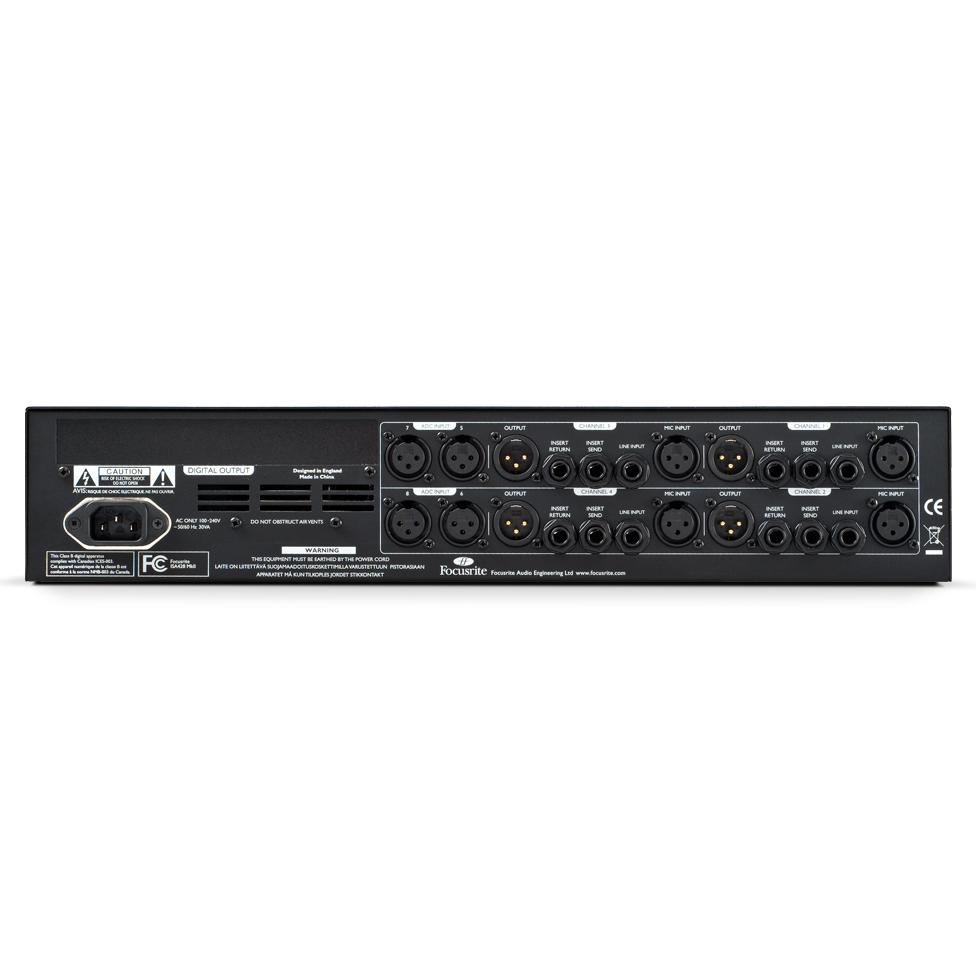Focusrite ISA 428 MkII Four channel preamp
Heritage Sound times four
Focusrite’s ISA mic preamps can be traced back to 1985, when console designer Rupert Neve was asked by Sir George Martin to create new modules for the console at AIR Montserrat. The modules he created included the legendary ISA110, on which all ISA microphone preamps are based. With their characteristic Lundahl LL1538 input transformer, along with one concession to modernity – variable input impedance – ISA mic preamps are very much the same as they were 30 years ago. But today, instead of solely gracing the consoles at AIR, ISA mic pres are at the heart of hundreds of hits made in leading studios and by leading engineers, artists and producers, across the world.
Four classic mic pres – with a little extra
Now in its second generation, the ISA 428 Mk II incorporates four of Focusrite’s renowned mic pres in a simple-to-operate 2U enclosure, placing four mic preamps, instrument inputs and line ins at your fingertips. The original Focusrite mic pre was designed to suit the microphones of the time; today’s model makes one small change, adding three additional input impedances to the classic ISA110 setting, allowing you to match any microphone, old or new, and access a wide range of sounds, from the character and warmth of a vintage mic to the clear transparency of a modern design. Or you can experiment and bring out just the qualities you want.
Front panel instrument inputs
In addition to the mic inputs, there are four front-panel instrument inputs making the ISA428 Mk II ideal for overdubs in the control room with no need for a DI box. On the back: four line inputs and switchable insert points on each channel to allow routing via external signal processors. There’s also a versatile, vintage design variable high-pass filter to control what’s going on at the bass end. And finally… accurate, 6-LED meters to tell you exactly what’s going down. Optionally available for the ISA428 Mk II is a precision eight-channel A-D converter with 122dB dynamic range and superb jitter performance – ideal for simple interfacing with your DAW.
Specifications
Mic Inputs
- Frequency response at minimum gain (0dB): -0.35dB at 20Hz and –3dB at 122kHz
- Frequency response at maximum gain (60dB): –2.5dB at 20Hz and –3dB 103kHz
- Gain range: 0dB to +60dB in 10dB steps, plus 0dB to +20dB continuously variable trim
- Maximum headroom: +7.4dBu
- THD+N: 0.0009% (measured at 1kHz -20dBu input signal, at 30dB gain setting, with a 20Hz/22kHz bandpass filter)
- Noise EIN: -126dB (measured at 60dB of gain with 150Ω termination and 20Hz/22kHz bandpass filter)
- Noise at main output with unity gain: -98dBu (measured with a 20Hz/22kHz bandpass filter)
- SNR: 123dB (relative to max output 25dBu)
- SNR: 120dB (relative to 0dBFS (+22dBu)
- CMRR: 88dB.
- Input Impedance, variable: 600Ω, 1400Ω, 2400Ω, 6800Ω
Line Inputs
- Frequency Response at unity gain (0dB): -0.3dB at 20Hz and –3dB at 94kHz
- Gain range: -20dB to +10dB in 10dB steps, plus 0dB to +20dB continuously variable trim
- Maximum headroom: +25.4dBu
- THD+N: 0.002% (measured with +4dBu input signal, 0dB gain setting, with a 20Hz/22kHz bandpass filter)
- Noise at main output with unity gain: -91dBu (measured with a 20Hz/22kHz bandpass filter)
- SNR: 116dB (relative to max output 25dBu)
- SNR: 113dB (relative to 0dBFS +22dBu). Input Impedance: 10kΩ
Instrument Inputs
- Frequency Response at +10dB gain: -0.2dB at 20Hz and 0dB at 200kHz
- Frequency Response at +40dB gain: -3dB at 20Hz and –3dB at 38.4kHz
- Gain range: +10dB to +40dB continuously variable
- Maximum headroom: +11.5dBu
- THD+N: 0.006% (measured with –20dBu input signal, at minimum gain (+10dB), with a 20Hz/22kHz bandpass filter)
- Noise at main output with minimum gain (+10dB): -95dBu (measured with a 20Hz/22kHz bandpass filter)
- Input Impedance = >1MΩ
High Pass Filter
- Roll off = 18dB per octave 3 pole filter
- Frequency range: 16Hz to 420Hz (continuously variable, measured at the 3dB down point)
Meters
6 LED meter is calibrated 0dBFS = +22dBu (the maximum level which can be correctly converted by the optional internal A/D converter before overload occurs). The meter calibration points are as follows:
- Meter panel calibration value in dBFS / Equivalent dBu value
- 0dBFS / +22dBu
- -2dBFS / +20dBu
- -6dBFS / +16dBu
- -12dBFS / +10dBu
- -18dBFS / +4dBu
- -42dBFS / -20dBu
Front and rear connectivity
Analogue Channel Inputs (Inputs 1-4)
- 4 instrument 1⁄4” TS jack inputs on front panel
- 4 microphone XLR inputs on rear panel
- 4 line 1⁄4” TRS jacks on rear panel
- 4 insert return 1⁄4” TRS jacks on rear panel
- 4 ADC XLR inputs on rear panel
Analogue Audio Outputs (Outputs 1-4)
- 4 line XLR outputs on rear panel
- 4 insert send 1⁄4” TRS jacks on rear panel
Other I/O
- IEC power input connector 100Vac – 240Vac
Front Panel Indicators
- 8 output meters, 6 segment
- 4 30-60 mic gain range selection indicator
- 4 +48V phantom power indicator
- 4 Phase indicator
- 4 Insert In indicator
- 4 Filter In indicator
- 4 Input selection indicators (Mic, Line, Inst)
- 4 Z In microphone input impedance selection indicators (Low, ISA110, Med, High) Clock select indicators (44.1, 48, 88.2, 96, 176.4, 192)
- Ext clock indicators (Lock, Word clock, 256X)
Weight
- 5.5kg
- 12.2lbs
Dimensions (W x H x D)
- 480mm (W) x 88mm (H) x 280mm (D)
- 19″ (W) x 3.5″ (H) x 11″ (D)

